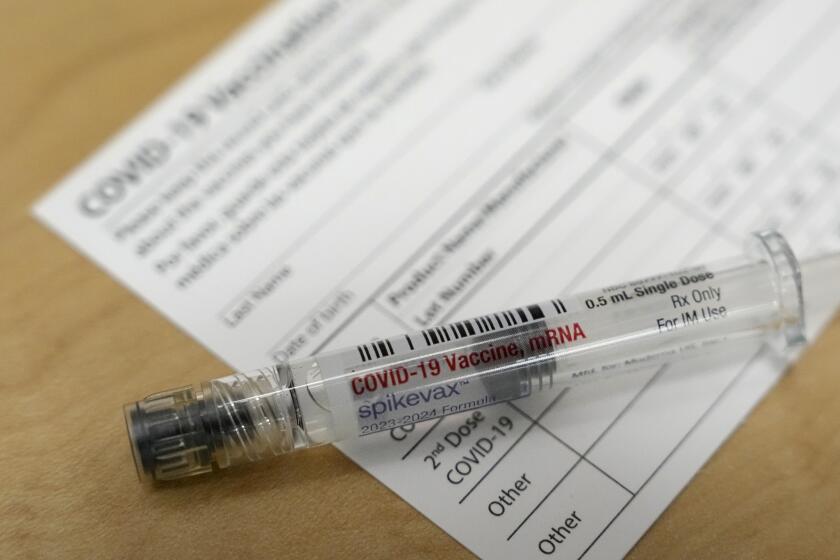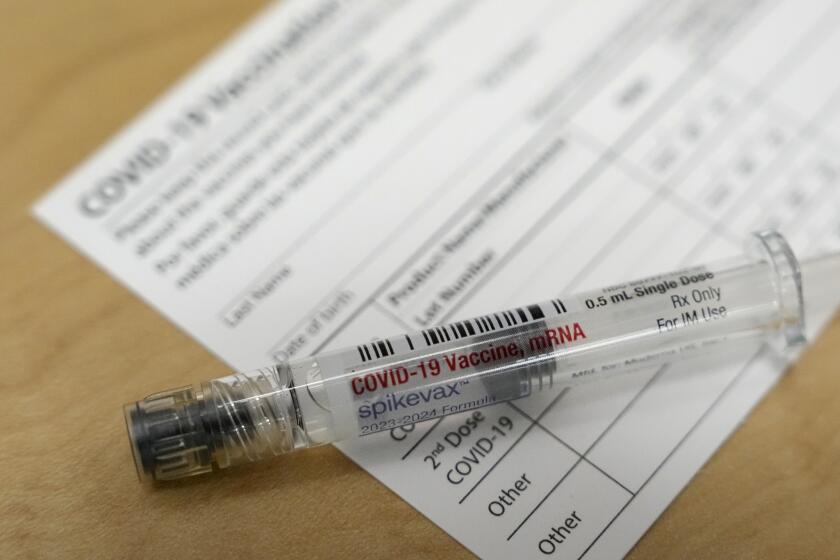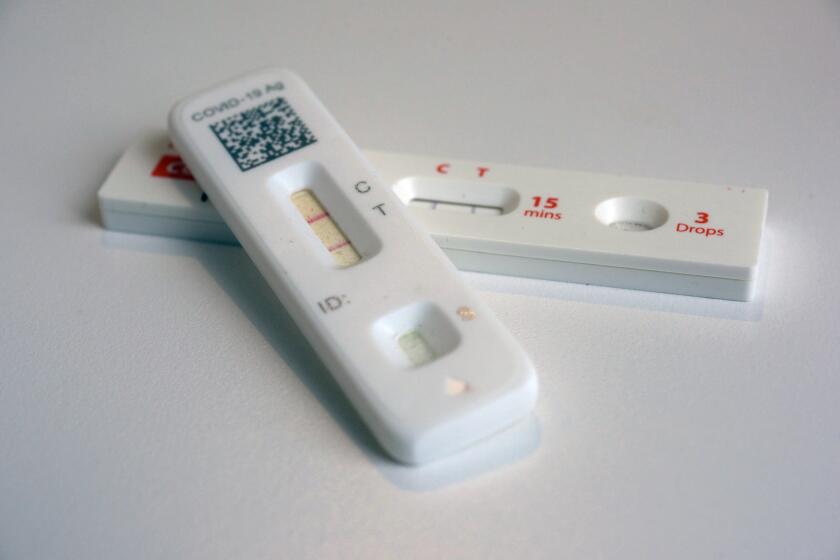L.A. COVID-19 cases falling again after summer uptick. Officials now brace for winter

- Share via
Los Angeles County is seeing its COVID-19 levels recede following a prolonged summer bump, a welcome reprieve before an expected climb in coronavirus transmission this fall and winter, health officials say.
“We’re definitely seeing a decline,” L.A. County Public Health Director Barbara Ferrer said in an interview. “The summer bump is over.”
For the week that ended Sept. 23, the most recent period for which data are available, coronavirus levels in L.A. County wastewater were at 19% of the peak seen last winter. That’s a significant decline from the previous two week’s readings of 30% and 38%, respectively.
Ferrer said she anticipates L.A. County will remain at a lower level of coronavirus transmission “hopefully for a few more weeks, until the weather gets colder, more things are moved indoors and there’s a lot more celebrations and travel” that could help spread the virus.
The current decline, she added, is “comparable to the experiences we’ve had in prior years for September and October,” she added. “It gives everybody plenty of time to get ready for November and December, when, historically, we’ve seen a lot more transmission and, sadly, that translated into more hospitalizations and deaths.”
People seeking the newest COVID-19 vaccine are running into problems getting it due to high demand, insurance headaches and supply delays coast to coast.
An important way residents can prepare, health officials say, is to get an updated vaccine. Those shots, much like the annual flu vaccine, have been formulated in hopes of boosting protection against coronavirus strains that are expected to widely circulate later this year.
Distribution of the updated COVID-19 vaccination has been much slower than anticipated, and shortages have persisted rather acutely in some locations, including some clinics that serve medically vulnerable populations and the youngest children.
But vaccine scarcity has eased elsewhere, and the L.A. County Department of Public Health now has the updated shots available at 10 locations countywide.
The updated COVID-19 vaccine is available at no cost, although insured people may need to choose an “in-network” provider to avoid an out-of-pocket cost. The county Department of Public Health, however, is considered an in-network provider for all insured people, and Kaiser Permanente members can get vaccinated through the county at no cost.
The new COVID shot is available at CVS and Walgreens at no cost through most insurers. But Kaiser enrollees must wait until Sept. 28 to avoid paying out of pocket.
Federal authorities are urging everyone age 6 months and up to get an updated COVID-19 vaccine this autumn-and-winter season, since protection from older doses weakens over time.
“Receiving an updated COVID-19 vaccine can restore protection,” according to the U.S. Centers for Disease Control and Prevention, and “last season, those who received a 2022-2023 COVID-19 vaccine saw greater protection against illness and hospitalization than those who did not.”
Aside from wastewater levels, there are other indications that the summer COVID-19 wave has crested.
Coronavirus-positive hospitalizations are also starting to decline. For the week ending Sept. 30, the most recent report available, there were an average of 463 coronavirus-positive patients in L.A. County’s hospitals per day. The summer peak was the week that ended Sept. 9, withan average of 620 coronavirus-positive patients per day.
A similar decrease has yet to be seen for COVID-19 deaths, which are a lagging indicator. For the week that ended Sept. 11, the most recent report available, there were an average of five COVID-19 deaths a day in L.A. County. Earlier in the summer, there were as few as one a day.
U.S. health officials are urging almost everyone to get both an updated COVID-19 shot and flu vaccine. An RSV shot is advised for older adults and women in late pregnancy as well.
Nationally, the summer COVID-19 wave is also declining. Coronavirus-positive hospitalizations peaked nationally over the summer the week that ended Sept. 9, with 20,625 admissions reported during that period. For the week that ended Sept. 30, the most recent report available, there were 18,139 coronavirus-positive hospital admissions, a 12% decline.
Even at their peak, hospitalization numbers this summer did not reach the heights seen in prior surges — a development health officials credited to widespread community immunity through vaccines and previous infection.
“But again, we do expect as we get into the fall and winter to see more circulating virus,” CDC Director Dr. Mandy Cohen told the “In the Bubble with Andy Slavitt” podcast last week.
The Biden administration is providing $600 million for new at-home COVID-19 tests and is restarting a website for Americans to order four free tests per household.
While it’s clear that COVID-19 is no longer the catastrophic threat it once posed, “it is still here with us. And we know that it is unfortunately still causing a significant amount of disease,” Cohen said. COVID-19 still represents more of a public health burden than the flu “in terms of making people really sick and dying,” she said.
“Most folks who are getting very sick from COVID are over the age of 65,” Cohen said. “That is definitely where we’re seeing most of our hospitalizations and most of our deaths.”
Still, the risk of severe COVID-19 disease or long-lasting complications persists to some degree across all age groups, Cohen said, “even down to our kids.” CDC data indicate 7% of adults are seeing extended symptoms from COVID-19, such as long COVID, even if they had a mild case, Cohen said.
Seventy percent of U.S. adults have an increased risk factor for some worse outcome for COVID-19, Cohen said.
“Even if you’ve been vaccinated before, or you’ve had COVID before, that protection decreases over time,” she said. “So as all the months tick by since the last time you had COVID or the last time you got a vaccine, more vulnerability builds up there.”
Data increasingly suggest getting vaccinated reduces long COVID risk, a factor officials have cited in recommending most everyone get a reformulated vaccine this year.
Among kids with COVID-19 who ultimately need intensive hospital care, half don’t have an underlying condition, such as asthma. That’s why it’s important for children and adults to get the updated vaccine this fall, Cohen said.
“We have given out more than 600 million doses of this vaccine. It’s one of the most studied vaccines now, in history, in terms of [its] safety profile,” Cohen said.
The U.S. government is also now allowing households nationwide to request four free coronavirus rapid tests to be delivered to them by mail. They can be ordered at covidtests.gov.
More to Read
Sign up for Essential California
The most important California stories and recommendations in your inbox every morning.
You may occasionally receive promotional content from the Los Angeles Times.



















